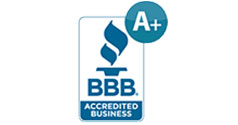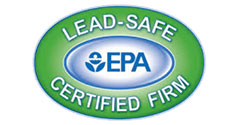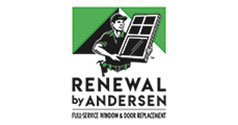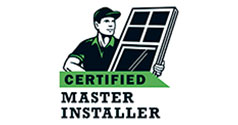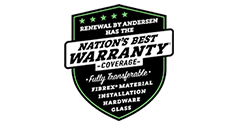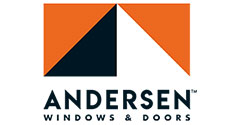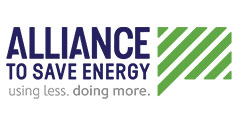Have a question about our installations, processes, or one of our products? Find answers to common problems, quick explanations of window and door jargon, and more in our FAQ below. We’ve grouped questions and terms into categories for your convenience.
Windows: Common, basic questions about windows and window terms
A window sash is the portion inside a single framing section, including those framing pieces and the glass attached to them. It is not the same as a full window frame, which is the frame around the entire window opening. For example, a double hung window has two sashes, but only one frame.
Double hungs are the most common type of window; they consist of two sashes, both of which move on tracks along the sides of the window frame. Double hungs with divided light or simulated divided light are extremely popular. With Mr. Rogers double hung windows, you can tilt the sashes in to wash the outside of the glass easily. They also lock on the top edge of the lower sash.
Double hungs are the most common type of window; they consist of two sashes, both of which move on tracks along the sides of the window frame. Double hungs with divided light or simulated divided light are extremely popular. With Mr. Rogers double hung windows, you can tilt the sashes in to wash the outside of the glass easily. They also lock on the top edge of the lower sash.
A gliding or sliding window consists of two sashes that move side to side on tracks along the bottom and top of the window frame. These are very easy to open and close and are extremely space-efficient.
A picture window is one, large window that does not move. It often frames a particularly nice view (hence the name "picture" window). Many people like to put a casement or gliding window on either side of a picture window for a combination of the large view and the option of opening the window.
An accent window refers to any window made to fit a non-rectangular space; a circular window or an arch window, for example. Mr. Rogers offers a wide variety of accent windows.
An awning window is similar to a casement window in that it swings open; instead of rotating to the side, however, an awning window opens up and out along a top hinge. Awning windows are noted for being very safe and easy to operate.
A bay window is a combination of windows: one large picture window sits in the middle while smaller windows flank either side at an angle. The side windows can be casements or double hungs. This is a beautiful window that offers the possibility of a window seat.
A bow window is a combination of windows: four, five, or six identical windows form a curve out from the wall. Each window is a casement or double hung window. This window is a majestic centerpiece that can come with a beautiful window seat.
Bay and bow windows are more alike than they are different, which is why they are so often listed together. Both are combination windows that extend out from their walls, both have the option of window seats, and both are beautiful additions to your home. The key difference is that a bay window consists of three windows: one picture window in the center and two casement or double hung windows on either side. A bow window consists of four, five, or six windows, all of which are casements or double hungs. Instead of extending at sharp angles, a bow window is a gentle curve.
Normally if you have an odd-sized window opening, the company will tell you they can't replace it, or they'll try to do it even though their window doesn't fit. You'll be left with an ugly, sloppily installed window that is drafty—or a window that the installer shoved into the opening and won't work right.
That's because most windows come from a huge factory line. They're one-size fits all. If they don't fit the opening, they have to try to make them fit.
Mr. Rogers Windows come from Renewal by Andersen. Renewal by Andersen makes windows that are custom fit to your specific window opening. Mr. Rogers sends a technician to accurately measure the window opening first, then your specifications are sent to Renewal by Andersen, who crafts the window to perfectly fit your home. So it will look amazing, stay airtight, and open and close smoothly.
Glass: Answers to glass and grille questions
Divided light means your window has several smaller panes of glass that are separated by divisions in the window, as opposed to having one solid pane of glass. Today, divided light is simulated with grilles that snap in place on the inside of windows, with grilles placed in between the two pieces of glass in a double-paned window, or with both.
Visible Transmittance (VT) is a measurement of how much visible light (the spectrum of light we can see) comes through a piece of glass. VT is expressed as a number between 0 and 1. Obscure, privacy, and tinted glasses have lower VT than normal glass.
Fixed light windows or fixed/stationary panels refer to a section of a window or patio door that does not move, open, or close. For example, picture windows are fixed light windows because they do not open or close. Patio doors and sliding windows often have fixed or stationary panels. These panels do not move. Instead, the other section of the window or door glides over the stationary panel.
You can also use stationary or fixed panels alongside a regular patio door to create stunning glass walls.
Obscure or privacy glass is any kind of glass designed to alter the view through it, whether it be for decoration, light reduction, or privacy. Mr. Rogers Windows offers a wide range of privacy glass.
Glazing refers to the panes of glass or plastic in a window, door, or skylight. A double glazed window for example, has two panes of glass. Double-glazed windows are often called double-paned windows.
Tempered Safety Glass is a type of glass that has been repeatedly heated and cooled. This makes the glass much stronger than ordinary glass. Also, if Tempered Safety Glass is broken, it crystallizes into small, harmless shards that won't cut or hurt curious little hands or pets.
You don't need Tempered Safety Glass unless you're dealing with an extremely large continuous glass surface such as a sliding door, in which case the stress of its own weight and the likelihood of something hitting it mean safety glass is a better option.
Also, Virginia and North Carolina building codes require any glass within 18 inches of the ground or 36 inches of a door to be made of Tempered Safety Glass. This prevents someone from kicking through a low window, and protects your house from someone breaking a window, reaching through, and unlocking the door.
Tinted glass has been mixed with certain minerals to create a darker, less transparent material. Tinting always reduces both visual light and thermal radiation transmittance. Tinted glass combined with Low-E glass, such as in Renewal by Andersen's High-Performance, Low-E4 Sun Glass, provides amazing energy savings.
Window Problems: Fog, rot, drafts, and other window ailments
Unfortunately, you can't clean these three types of windows from inside. If these windows are on your ground level, you can go outside to clean them. Otherwise, we don't recommend doing it yourself, which would involve a ladder and potential safety issues.
Rotting wood is a frequent occurrence in wood windows. Even vinyl-clad wood windows often suffer from rot damage as water and moisture seeps in between the wood frame and outer vinyl layer.
However, just because this is a common problem with wood windows, don't be fooled. Wood rot is a serious issue that can lead to many more serious issues in your home. Not only does rot weaken the frame of your windows, it can also lead to mold growing in the frame and in the walls of your home, causing a serious health risk to you and your family.
Of course, once rot has set in, the absolute best thing you can do to protect your home and your family is to replace the windows. Wood rot cannot be treated or cured. It's a problem that will lower the value of your home, even if it's only a small amount, because no matter what you do, the windows and surrounding wood will eventually have to be replaced.
At Mr. Rogers Windows, when we replace your old rotting windows with Andersen FIBREX® windows, which are guaranteed never to rot, we will also repair any rot or mold damage in the surrounding wall areas that could be hazardous to your home and health. And, we'll repair the damage at no extra charge to you. It's just one of the ways that Mr. Rogers ensures you 100% guaranteed professional and quality installation.
If you aren't ready to replace your windows just yet, here are a few ways you can help to prolong the life of your wood windows once rot has already set in:
- The first thing you can do is to check the caulking around the windows. Make sure it's in good condition and isn't cracked, chipping, or peeling. The seal the caulk is making between your windows and the house needs to be good and tight, or more water and moisture will leak in, and accelerate the rotting process.
- It's also important to make sure your house is primed and painted. This creates another layer or barrier that moisture will have to penetrate, and adds a little more protection from the rot spreading.
- If you have storm windows, be sure to keep the weep holes (where trapped water drains out) clean and unclogged. If water gets caught and sits between your windows and the storm windows, any rot that has already begun will more easily spread to the rest of your window and the surrounding walls.
Air leakage (or air infiltration) refers to the amount of air that leaks into or out of a building by means of cracks in the walls, windows and doors. It's important to make certain that professional installers accurately measure and install your windows in order to minimize air leakage, which can cause drafts, over-heated homes or over-cooled homes, and higher energy bills.
First, know that condensation and fogged panes are two different things. Fogged panes happen when moisture gets in between the two panes of glass. If you can clean the moisture, it's condensation, not fog.
Condensation is not necessarily a window problem. It occurs any time warm, moist air comes into contact with a cooler surface. Condensation can cause paint to peel or flake, wood to rot, and mold to grow. Mold can be a serious hazard to health, especially for people with allergies.
On the outside of the window, condensation is just dew—just like the dew that gathers on grass. The window merely provides a place for dew to form. This is not a problem.
Condensation on the inside of a window is a sign that your house has excess humidity. Often this happens in homes during the winter, as the warm, moist inside air comes into contact with colder windows.
Excess humidity can come from a variety of sources, including cooking, humidifiers, and taking baths and showers. To reduce condensation, make sure your house is well ventilated, and avoid using a humidifier during the winter if you can. However, if you need a humidifier for health reasons, do not discontinue use.
The only time condensation is indicative of a window problem is when you have metal windows, such as aluminum windows. The metal transfers cold into your house, and large amounts of condensation gather around the metal frame inside the window.
The fog that gets in windows is not what most people think it is; it's not the actual water vapor that gets between glass panes in your window. Fogging is the solid residue, usually hard minerals, which the water vapor carries with it. When the sun evaporates the water, the minerals are left on your window.
Fogging happens when the seal between the two panes on a double-paned window fail. This can happen in a variety of ways.
One way is when the object that keeps the two panes apart, a spacer, comes loose. Spacers have traditionally been made of materials like aluminum or plastic, which tend to shift around, transfer too much heat into the home, warp, or in plastic's case, completely melt.
Another way is when the window expands and contracts too much under temperature changes. The window frame pulls away from the glass and the seal fails. This is especially a problem with vinyl windows.
Besides ruining the view of your window, fogged panes also signal that the insulation value of your window has been compromised. The effectiveness of double-paned windows comes from the pocket of air in between the two pieces of glass. Air or gasses like argon have a higher insulating value than glass alone. Heat cannot pass through it as easily.
However, once the seal is broken on a window, the argon or air inside escapes. The insulating value of your double-pane decreases, and your energy bills go up.
Also, if you have one window that is fogged, any other windows of the same brand or that were installed at the same time are at risk. Seal failure is a result of poor installation or design. If one window fogged up, the rest probably will too.
Unfortunately, the fog in your windows is there to stay. You can't just take off one pane of glass and wipe it down.
However, beware. Some companies claim to be able to "vacuum" the fog out of your windows. They drill a hole in your window and suck the fog out.
Common sense says this will not work. For one thing, that "fog" is actually the mineral residue left behind when the water evaporates. There's nothing to "suck" out. Even if the fog could be sucked out, it would do nothing to address the actual problem—which is that the seals on your double-paned windows have failed. Once those seals have failed, the fog is there to stay. Even if you managed to clean it out, the fog would come back because the seal has failed.
The only way to get rid of the fog for good is to get new windows.
The first and most important thing you can do to keep your windows opening and closing smoothly is to get FIBREX® windows from Mr. Rogers Windows. Wood, vinyl, and aluminum windows can become swollen or rusty, making them hard to open and close. FIBREX® resists warping, swelling, rotting, and rusting.
Plus, with professional installation your windows will be square, level, and plumb. You can open and close your windows easily. Sloppy window installation leads to windows that are at an angle, so you have trouble operating them.
However, maintenance is required from time to time. Just like a car, the parts of your window need to be cleaned and lubricated occasionally. See our cleaning section to discover how to properly lubricate your windows.
Drafts come through your windows for a number of reasons. Your window might not have a tight seal, the glass might not be insulating well enough, or the sashes might not be shutting properly.
You can attempt to thwart drafty windows with a few measures:
- Caulking: Inspect the caulking on the outside of the window. If the caulking has thinned or cracked, air and moisture can get through your window into your house. Recaulk your window if needed.
- Locks: Check the lock on the window. A good lock pulls the two sashes tightly together, creating an airtight seal. If the lock is faulty or worn out, it may be leaving your windows open a tiny bit, letting in air. A new lock may help to keep drafts out.
- Curtains and blinds: Keep your blinds and curtains closed, even in the winter. Especially keep them tight around the edges of your window. Contrary to popular belief, blinds and curtains do not keep heat or cold out. Once the air passes through the window, it's in your house. However, this may keep drafts and heat from blowing directly into your house and on you, so you'll be more comfortable. The temperature in your house will still be affected.
- Plastic: Any local hardware store should sell the materials you need to do this. Get a sheet of heat shrinking plastic. Cut it to the size of your windows. Use a roll of double-sided tape to stick the plastic to the windows. Now use a hair drier to heat the plastic, which will shrink, creating a tight seal on your window.
- Storm windows: Storm windows are a stopgap measure. In the winter, they provide an extra seal on your windows. In the summer, storm windows offer negligible energy savings. Many people choose to take down their storm windows in the summer to let the breeze in. If you already have storm windows, make sure they're locked. Storm windows need to be locked to keep air and moisture out.
- Crooked frames: Look at the bottom of your window where the sash meets the frame. Does the window close level with the frame? If not, then your house has probably settled. The window frame, too, has settled, and is no longer in alignment with the sash. The sash cannot close all the way, leaving a gap for air to seep in. There is no fix to this problem aside from replacing the window.
All of these ideas are, at best, temporary measures. If your window is drafty, it will become drafty again—costing you money and comfort.
The best solution is to buy new, energy-efficient, professionally installed FIBREX® windows from Mr. Rogers Windows.
Thermal expansion is any change in the volume of a material when it is subjected to changing temperatures. Vinyl is extremely vulnerable to thermal expansion, while FIBREX® and wood are not. Excessive thermal expansion can lead to warping or bowing of the window frame, resulting in drafty and fogged windows.
Window Materials: Info about window materials, including advantages and drawbacks
FIBREX® is a wood/vinyl composite material made exclusively by Andersen. Because it combines the strength and classic look of wood with the rot-resistant, maintenance-free qualities of vinyl, FIBREX® offers the features and benefits of the two most popular types of window materials on the market.
Wood is classic. It looks good. It's strong. It's a great insulator. However, wood is attracted to water. Depending on the location of a wood window, it can be greatly impacted by rain, shade, and moisture. To help protect the wood from rot and damage, the wood window requires a lot of maintenance. They require painting to help protect the wood from damp, wet weather. And to keep the window from crumbling around the small panes of glass, homeowners need to scrape, caulk and paint the wooden dividers. Common problems with wood windows occur because of all the painting. Sometimes they get "painted shut" and can no longer be opened. And even worse when the weights and pulleys wear out, you are faced with propping you window open with a stick or book.
Although some may believe that craftsmanship and product quality have fallen over the years, the reason why wood windows aren't as good as they once were is simple: back then, wood windows were made from better trees. For decades in the 1900's, most wood came from old-growth forests. These are some of the world's oldest forests, containing some of the highest quality lumber. In terms of strength, rot-resistance, and insulation, this wood is superior—which is why those windows lasted longer than today's wood windows. Sadly, most of these forests are now lost due to logging. The few old growth forests that remain are for the most part protected. Wood nowadays is harvested from trees planted 20-30 years ago. These trees haven't had much time to grow, especially compared to old growth forests. The wood is weaker when it comes to strength, rot-resistance, and insulation. However, FIBREX® is made from recycled wood from Andersen's own plants. Andersen makes FIBREX® windows without cutting down any trees. And with FIBREX®'s revolutionary mix of vinyl and wood, FIBREX® performs as well as wood in every area, and surpasses it in many ways.
Vinyl windows are made of Polyvinylchloride, which is a plastic material used for window framing and 60% of the equation for FIBREX®. It is inexpensive and durable. However, by itself vinyl windows are subject to thermal expansion, deterioration from ultraviolet light exposure, warping, bowing, and discoloration. To counter this, many vinyl windows come reinforced with metal bars or extra vinyl. This adds some strength to the window; however, reinforced vinyl window frames are very bulky, they impact the architectural integrity of your home because they hardly look like your original windows. Plus the wide frame takes up large amounts of glass and can ruin your view. In FIBREX®, however, the vinyl PVC bonds to wood fibers. The wood gives the vinyl strength, keeping it from warping or peeling away. And the vinyl protects the wood from moisture and rotting. Plus, since FIBREX® is so strong, you get narrow window frames, plenty of glass, and an amazing view.
Today, aluminum windows are mainly used in new construction to save money on building costs. Few window companies will sell you aluminum windows for one reason: while it may be strong, aluminum is terrible when it comes to energy-efficiency. Aluminum is an amazing conductor of heat—that's the reason you use aluminum foil to cook. But you don't want your windows to let in so much heat during summer and make your home colder in the winter. This can cause your energy bills to skyrocket and lower the comfort level of your entire house.
Fiberglass found its way to the market in the 1930's for thermal insulation and air filters. Eventually, glass fibers were combined with epoxy resins and thermosetting polyesters to be engineered into boats, automobile bodies, sporting equipment and electronics. And later still, fiberglass window frames.
Fiberglass is strong and rigid. It is not affected by moisture. However, fiberglass windows have some important shortcomings. First, the corners of the window cannot be fusion welded. The sides of the windows are screwed together. As a home settles the screws are susceptible to loosening. As the frame loosens it can affect the glass seal resulting in fogging and condensation.
UV rays are the biggest problem for fiberglass. UV rays affect fiberglass by causing it to fade, discolor, and flake. Regular maintenance is required to keep the fiberglass from falling apart.
Patio Doors: Terms and problems relating to patio doors
Sliding glass doors have one or more panels that move horizontally on a track or in grooves. A French door refers to a door that swings open on a hinge. Both are popular as doors to and from patios, decks, and sunrooms; choosing between them is a matter of considering the space you have and what kind of look you want.
Your patio door is probably letting in cold and heat because the glass does not insulate well. Like old windows, old patio doors aren't very energy efficient. New patio doors can come with all the same technology as new windows, including Low-E coatings, double panes, and argon-fill. These modern conveniences keep the heat out in the summer and the warmth in during the winter. The other possibility is that your patio door is drafty. During the winter, if you walk by and fill chilly air, then your patio door probably lacks a weathertight seal. This could be because of faulty installation, poor weatherstripping, or a defective door. Although you can reweatherstrip your patio door, there is little you can do if the door is broken or was installed wrong. Andersen patio doors from Mr. Rogers Windows are double-paned, argon-filled, and coated with Low-E4. Independent testing has proven they're 56% more energy-efficient in the summer and 47% more in the winter. That's more comfort for you and more energy-savings in your pocket. Plus, Mr. Rogers Windows only uses certified installers, so you know your patio door is installed perfectly.
Footnote: Values are based on comparison of Renewal by Andersen® double-hung window U-Factor to the U-Factor for clear dual pane glass non-metal frame default values from the 2006, 2009, 2012, 2015, and 2018 International Energy Conservation Code “Glazed Fenestration” Default Tables
Like anything, patio doors experience normal wear and tear. The tracks and rollers that enable you to open and close your sliding door can rust, warp, or become dented, making your door difficult to operate. In some cases, you can fix this problem by greasing the track with a silicone spray or by replacing the rollers (hardware stores often carry patio door rollers).
Some patio doors are hard to open and close because of poor installation. If the patio doors aren't square and level, they won't fit into the track correctly, and you'll struggle to use them.
Andersen patio doors from Mr. Rogers Windows come with stainless steel tracks and rollers and self-adjusting levelers. The stainless steel resists warping and rust, ensuring smooth operation. And the self-adjusting levelers mean your patio door is always square and fit. Plus, Mr. Rogers Windows only uses certified installers who take the time to make sure your patio door is installed right.
Patio doors become foggy for the same reason as windows. If the seal on your double-paned patio door glass have failed, moisture infiltrates the space between the glass. When the sun evaporates the moisture, mineral deposits are left on the glass. These deposits are the "fog" you see.
Fogged glass is a sign that your glass is no longer insulating as well as it could be. The layer of air or gas, which provides most of the insulation in double-paned glass, has escaped, so the insulation value of your door has decreased.
Fog inside glass is there to stay. To get rid of it, you would have to replace the glass itself—which can be very expensive—or just replace the patio door. Beware of some companies who claim to be able to "vacuum" the fog out of patio doors. First, the "fog" is mineral residue. It can't be "vacuumed" out. Second, even if you could vacuum out the fog, that would not address the underlying issue, which is that the seal on the double-paned glass has failed.
The best choice you have is to get a new patio door. Andersen patio doors from Mr. Rogers Windows come with stainless steel spacers that keep the double panes sealed. Made from strong stainless steel, and guaranteed to resist seal failure or heat transfer, you'll never have to worry about fogged patio doors again.
Tempered Safety Glass has been repeatedly heated and cooled. This process makes the glass much stronger than regular glass. And if it does break, it crystallizes into tiny, harmless shards that won't cut or hurt curious children or pets. Patio doors, entry doors, sidelites, and other large glass surfaces are usually required to be made with tempered glass.
Andersen patio doors from Mr. Rogers Windows come standard with tempered safety glass.
Laminated glass refers to glass with a transparent layer of plastic that any broken glass will adhere to, making it safer and also reducing noise. It basically is the same as the material in the laminating machine your teacher used in elementary school.
Laminated glass is not the same as the tempered glass used in patio doors. While both have safety benefits, laminated glass is primarily used to reinforce car windows.
Entry Doors: Sidelights, transoms, strike plates and more
Sidelite windows are only sold as part of our complete door replacement systems. They are not sold separately.
A sidelite is a panel on one side of an entry door, usually with some glass in it, sometimes almost entirely glass.
The steel gauge tells you how strong that steel is. The important thing to remember is that a lower gauge equals stronger steel. So a 22-gauge steel door is stronger than a 24-gauge steel door. Some companies advertise 26-gauge steel doors as the "Highest Gauge Steel Doors on the Market." While technically true, this is dishonest marketing as it preys on customers who don't know the facts.
ProVia steel doors from Mr. Rogers Windows are made from 20-gauge steel. You get 49% more steel than a standard steel door. Most steel doors are only made from 22-gauge or 24-gauge steel.
Polyurethane is a material used in many products. In ProVia® doors, polyurethane makes up the insulating core of the door. The polyurethane core in ProVia® doors is specially designed to be rigid and to resist the transfer of heat and cold. A door made entirely of steel or fiberglass would transfer too much heat into and out of your home. By wrapping steel and fiberglass around the polyurethane core, and by designing the core to be rigid, you gain energy performance without sacrificing durability or structural integrity.
Security plates reinforce your lock. Most security plates are only made of wood. If a burglar kicks your lock, the deadbolt will often rip through the wood itself and your door will come open. By reinforcing the security plate with metal, your door is resistant to kick in attempts.
All ProVia® doors from Mr. Rogers Windows come with 20-gauge steel security plates.
Q-lon is a brand of weatherstripping used in all Provia® doors. Compared to normal weatherstripping, Q-Lon has a number of benefits:
- Resists compression, shrinking, or stretching—it retains its full shape and size to provide a superior seal for years to come.
- Absorbs sound, giving you peace and quiet.
- Repels water.
- Resists rot, mold, and mildew.
- Does not freeze to surfaces, letting you open and close your door with ease year round.
- Will not break down because of UV light exposure or ozone.
Q-Lon weatherstripping is also 27% larger than standard weatherstripping. It is designed to make contact with the door even if the door is improperly closed or warped out of shape. Because of Q-Lon weatherstripping, your door will have a weathertight seal for years and years to come.
Installation and Service: What to expect from a Mr. Rogers Windows installation
From the initial call to the salesman to the day your windows are installed usually takes around eight weeks. Certain times of the year are busier or less hectic than others, so the entire process can sometimes take as little as six weeks or as many as 14. However, customer care is important to us, so we try to make the experience as pleasant and quick as possible and keep you up to date throughout.
Plan for about one hour to one and a half hours for each window.
The short answer: no. We do ask that you clear photos, books, knick-knacks, or any other objects on the actual windowsill off, and that you leave us a clear path from the entrance to your window so that we can carry our equipment in and out, but we do our best to take up as little space as possible. If you have furniture in the way, we'll move it and then put it back in place for you when we're done. Our goal is to make this process as easy as possible for you.
Some subcontractors and window installers pull up in a pick-up truck, pull out their mechanical equipment, their sheet cutters, and everything else they have, then dump it on your lawn. That equipment stays there until the job is done.
At Mr. Rogers Windows we don't want your lawn to look like a junkyard. Moving all that equipment onto your lawn can kill your grass and flowers. Carrying lots of tools into your house leads to a big mess.
That's why we try to contain our worksite. We do this with our specially designed truck-workshops. These are large trucks (think moving vans) with an entire window workshop loaded inside. All the tools and machinery our installers need to do the job is inside—so nothing has to go on your lawn except a few trashcans, which we'll take with us when we're through. And, when we leave for the day, all that machinery goes with the truck, so it isn't left at your house.
Even better, the trucks come with their own generators. Our installers use our electricity—not yours.
The installers also roll out the red carpet to protect your floors. They keep all of their tools and other items in a cart they wheel down the runner to whichever interior window they're working on. Tools and materials won't be scattered all over your house.
The only things you should notice after a window installation are the beautiful, new windows. You shouldn't have to pick up trash, deal with dirty carpets, or wash fingerprints and grease off your windows.
All Mr. Rogers Windows installers clean up after they finish installing your windows and doors. This includes wiping out and vacuuming the window tracks, cleaning the windows so they sparkle, vacuuming your home, and picking up any trash from the installation. After a Mr. Rogers Windows installation, the only thing you should notice is beautiful new windows and doors.
Energy Efficiency: U-Values, R-Values, and saving money on energy bills
Independent testing has proven that FIBREX® material windows with High-Performance™, Low-E4® glass is 56% more efficient in summer and 47% more energy-efficient in winter than ordinary dual pane glass.
Footnote: Values are based on comparison of Renewal by Andersen® double-hung window U-Factor to the U-Factor for clear dual pane glass non-metal frame default values from the 2006, 2009, 2012, 2015, and 2018 International Energy Conservation Code “Glazed Fenestration” Default Tables
Are storm windows as good as double-paned windows? Do they save as much when it comes to energy costs?
Short answer:
No.
Long answer:
While storm windows do not save as much energy as double-paned windows, they do save some energy. If you have single-paned windows, storm windows can especially help in the winter. They operate on the same principle as double-panes: an insulating layer of air between two layers of glass (or plastic, in the case of lower-end storm windows).
However, in storm windows, the seal between the two pieces of glass is not as tight, and argon gas is not present to add insulation value. In double-panes, the space between the two panes is also very small to eliminate convection currents that carry heat. Convection currents are circular movements within a gas (such as air) that are caused by expansion as its temperature rises. In a storm window, that space is large, so the insulation value is not as great.
In the winter, this doesn't matter. You need heat to stay in your house. Storm windows do save a little money in the winter. In the summer, though, storm windows lose whatever advantage they have. Convection currents carry large amounts of heat into your home. Energy savings from storm windows in the summer, or in hotter climates, is negligible. Many people remove their storm windows to allow the breeze in.
So double-paned windows are better at saving energy and keeping your house comfortable. However, if you're operating under a budget and want to save some on energy bills, storm windows are an option.
Low-emissivity, or Low-E, refers to a type of glass that has a coat of micro-thin metal applied. This coating reduces the heat transmission of your glass. In the summer, Low-E reflects the sun's heat, keeping your house cool. During the winter, Low-E keeps your warmth inside.
Low-E does not effect how much light gets into your house. Only the sun's heat, not its light, is being kept out. You cannot see the coating of metal on your windows. The view is kept crystal clear.
Note that Low-E glass is not the best glass if you live in a very cold climate. Anyone who lives in the far north and needs the heat from solar gain (and thus doesn't need to cool their house), should look into Hard Coat Low-E glass. This glass lets in more of the sun's warmth, helping to heat the home.
Not at all. The range of light plants need for photosynthesis is not reflected by Low-E.
UV rays can fade fabric and furniture over years of exposure. However, it's a myth that all Low-E coatings reflect UV rays. Most Low-E glass does not reflect the range of light that accounts for UV radiation.
Only specially designed glass, like High-Performance Low-E4 used in FIBREX® windows, block UV radiation—and keep your fabrics looking like new. High-Performance Low-E4 blocks 95% of UV rays.
Footnote: Values are based on comparison of Renewal by Andersen® double-hung window U-Factor to the U-Factor for clear dual pane glass non-metal frame default values from the 2006, 2009, 2012, 2015, and 2018 International Energy Conservation Code “Glazed Fenestration” Default Tables
The four in Low-E4 refers to the added benefit of a titanium dioxide coatings. Short story: it makes your windows easier to clean.
Long story: Low-E4 has both a coat of Low-E, and another micro-thin layer of titanium dioxide applied. When your windows get wet and the sun shines on them, the titanium dioxide reacts with the light and moisture to break down biological materials such as dirt or insect residue. This makes cleaning your windows easier, as you can wipe the dirt or residue right off instead of having to scrub or even scrape to get your window clean.
Energy Star is a program started by the Environmental Protection Agency and the Department of Energy to encourage energy-efficient products and help consumers find those products. A product has to meet certain requirements to earn the Energy Star label.
Windows that meet Energy Star requirements save you money on energy bills by insulating your home better. Almost all windows meet Energy Star requirements these days. However, many windows go above and beyond the guidelines set by Energy Star.
Andersen was one of the first window and door manufacturers to partner with Energy Star, and since then it has met and exceeded Energy Star requirements. For example, the most basic Energy Star guideline is that a house full of those windows must save the homeowner 12% on electric bills. Mr. Rogers Windows and Doors offers Renewal by Andersen® replacement windows with glass options that are ENERGY STAR® certified in all climate zones.
Footnote:
Residential Windows, Doors and Skylights for Consumers. U.S. Environmental Protection Agency. n.d. www.energystar.gov (accessed April 4, 2017). Savings may vary geographically and may vary based on other home insulating attributes. “ENERGY STAR” is a registered trademark of the U.S. Environmental Protection Agency.
ENERGY STAR criteria differs by climate zone, please review the ENERGY STAR requirements in the climate zone where the product will be installed and refer to the Renewal by Andersen NFRC Ratings/ ENERGY STAR Qualifications sheet to select the product. https://www.renewalbyandersen.com/homeowner-help/energy-taxcredit.aspx
Argon is an inert, nontoxic, invisible, odorless gas that is used to fill the space between the panes of glass in double- and triple-paned windows. Argon gas in windows helps reduce the amount of heat transferred in and out of your home. Because the molecules that compose argon gas are heavier than those of air, the gas functions as a much more efficient heat barrier than air, so the argon gas helps keeps your home well insulated and energy efficient.
Krypton is actually a chemical element; it's an inert gas like argon that is used to insulate windows and reduce heat transfer. The reason Mr. Rogers doesn't use krypton is that it costs up to 100 times as much as argon, and insulates only marginally better. And in case you're wondering, the element's name came before the comic book; krypton gas was discovered in 1898.
R-Value measures how much heat individual parts of a window resist heat transfer (for example, glass and framing material are tested separately). However, R-Value does not necessarily address the entire window's performance.
Materials with higher R-Values insulates your home better than materials with low R-Values.
Also known as the U-Value, this measures the rate of heat transfer through a material. The U-Factor is the most effective measurement for window performance. While R-Value measures the performance of the individual parts of a window, U-Factor measures how well the fully assembled window resists heat transfer. Every aspect of a window, from the spacer, to the glass, to the framing material, to the gas fill, affects performance. U-Factor measures all of it.
U-Factor is the opposite of R-Value when it comes to measurements. The lower the U-Factor the better. A window with a low U-Factor insulates your home better and has higher heat transfer resistance.
The SHGC is a measurement of solar heat radiation that is transferred or absorbed through a window and then released into your home. SGHC refers to a window's or door's ability to shield solar radiation by means of Low-E coatings, argon gas fills, and any other methods such as tinting. The rating for the solar heat gain coefficient is expressed as a number between 0 and 1. The lower a window's or door's rating, the less solar energy it transmits, and the more effectively that window or door will insulate and protect your home from heat gain.
Shading coefficient is a number that measures how much light a window lets through relative to a standard 1/8-inch thick piece of clear, double-strength glass. Most measurements for windows now are in solar heat gain coefficient (SHGC). If you want to convert between them, the approximate ratio is that SC = SHGC x 1.15
Conduction is the term for heat transfer through solid material. Heat naturally moves from a higher temperature to a lower one. So in the summer, the outdoor heat affects the inside of your home; in winter, the heat inside your home leaks out into the cold outside. It's like nature trying to balance the scales of hot and cold—except we obviously want to control our own comfort.
The best way to avoid heat loss and gain due to conduction is to have double-paned windows with Low-E coatings and a tightly sealed, argon gas barrier. And choose a framing material with high insulating properties, such as FIBREX®.
Mr. Rogers Windows comes standard with double-panes, Low-E4 coatings, and argon gas. They resist conduction, control your comfort, and save money on energy bills.
Heat gain and heat loss both describe the same action, just in different directions. Heat gain involves heat from outside coming into your home through the processes of conduction, convection, and radiation. Heat loss involves heat from inside transferring outside by the same processes. Windows and patio doors are crucial areas for heat gain and loss, as they are usually the largest openings in your home and therefore are most vulnerable to heat gain and loss. That's why it's so important to get energy-efficient windows and doors.
No. Radiation, in this case, is a measure of how much heat radiates from one object to another—for example, from the sun to your window, from your window to the inside of your home, and vice versa.
Terms: Window and door jargon and organizations
The American Architectural Manufacturers Association. The AAMA is a national trade association that works to create standards for the window, door, storefront, curtain wall, and skylight industries. You can find information about performance, certification, installation, and maintenance of these products through the AAMA.
The National Fenestration Rating Council is a nonprofit organization that rates windows, skylights, and doors in terms of energy efficiency. The NFRC label on a window or door product provides you with all the information you need to know about the energy performance of a product by giving numerical ratings to the U-Factor, Solar Heat Gain Coefficient, Visible Transmittance, and Air Leakage. These ratings tell you how well a window or door conserves energy and saves you on heating and cooling bills.
Fenestration is the technical word for windows, doors, skylights, or any opening in your home. Defenestration, by the way, is the act of throwing something or someone out a window.
Extrusion refers to the process of shaping vinyl, FIBREX®, or aluminum by forcing it through a mold at high heat. Extrusion can also refer to any window piece or item made through this process.
This is a feature of the Schlage Keyless Touchpad Electronic Entry System, available on ProVia entry doors. It actually refers to two different security features the Touchpad uses to protect your doors:
- Code Hopping prevents eavesdroppers from recording your code, then replaying it to "trick" the lock into opening.
- Anti-Scan technology prevents people from using devices that randomly attempt to guess your code.
Basically, Anti-Scan Code Hopping technology protects your doors and keeps your family safe.



